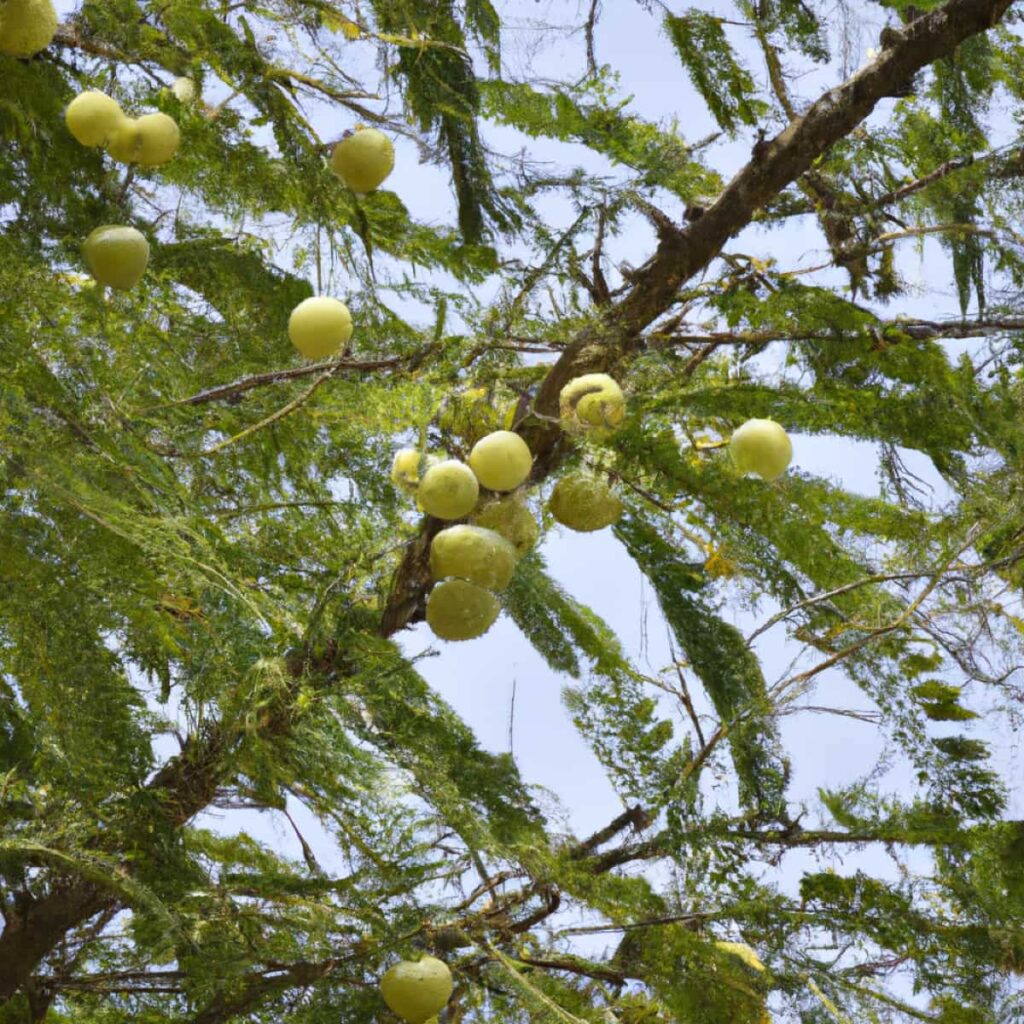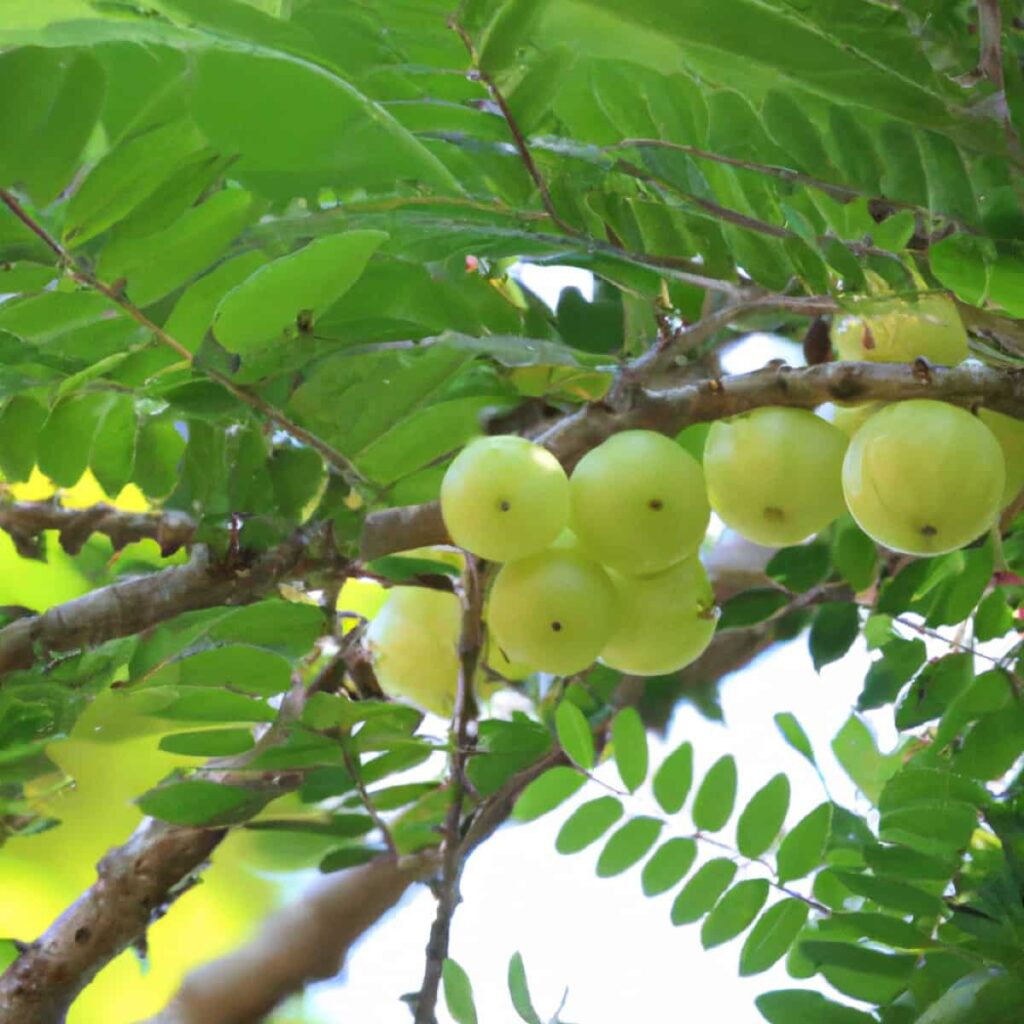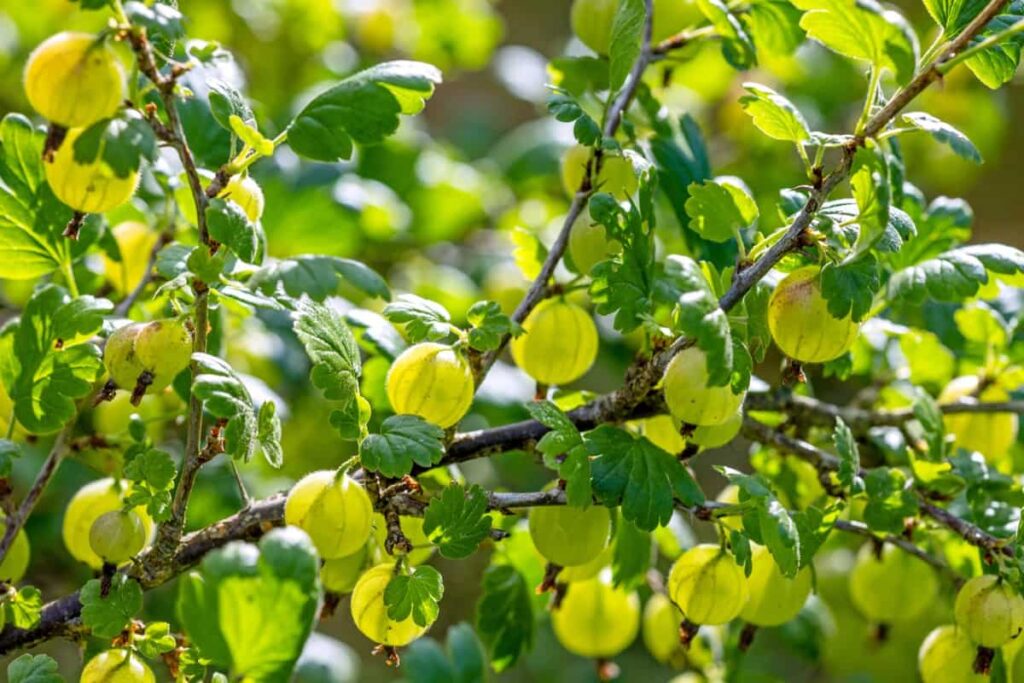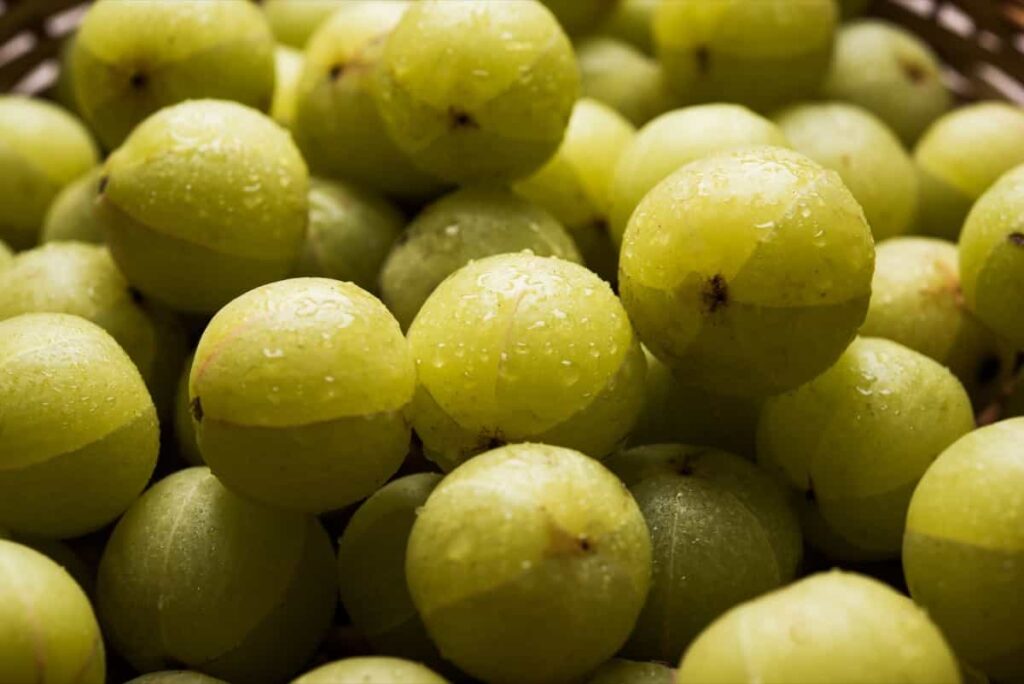Welcome to our comprehensive guide on optimizing the harvest of Indian Gooseberry, also known as Amla, in your orchards. Whether you’re a seasoned farmer or a novice enthusiast, this month-wise guide will equip you with valuable insights to manage your Amla orchards and maximize your yield effectively.

From the early stages of pruning and soil preparation to the final moments of harvesting, we will take you through the entire process, providing accurate and up-to-date data at every step. Each month, we will delve into the specific tasks and considerations that must be addressed, ensuring you clearly understand.
Indian Gooseberry/Amla Orchard Management
What is Indian Gooseberry/Amla Farming and its Overview?
Amla farming involves cultivating the Phyllanthus emblica tree, known as Indian Gooseberry or Amla, for its nutritious and medicinal fruit. The tree is small to medium-sized, up to 8 meters (26 feet) tall. Its leaves are light green and resemble pinnate leaves. Indian Gooseberry, scientifically known as Phyllanthus emblica or Amla, is a deciduous tree belonging to the Phyllanthaceae family. It is native to tropical and southern Asia.
The tree is small to medium-sized, ranging from 1 to 8 meters (3.3 to 26.3 feet) in height. Its branchlets are covered with fine hair-like structures and can measure 10 to 20 centimeters (3.9 to 7.9 inches) in length. The leaves are simple, subsessile (almost stalkless), and densely arranged along the branchlets. They are light green and resemble pinnate leaves.
The flowers of the Indian Gooseberry are greenish-yellow in color. The nearly spherical fruit appears light greenish-yellow and has a smooth, hard texture. It typically displays six vertical stripes or furrows. The diameter of the fruit can reach up to 26 millimeters. While wild Amla fruits weigh around 5.5 grams, cultivated fruits average between 28.4 grams and 56 grams.
Importance of Month-Wise Planning for Indian Gooseberry/Amla Orchard Maintenance
Each month presents unique tasks and considerations that directly impact the health and productivity of the orchard. From pruning and fertilization to pest control and irrigation, strategic planning ensures the timely execution of these activities. For example, pruning in winter stimulates new growth, while fertilization in spring promotes fruit development.
Adequate planning optimizes resource utilization, minimizes risks, and enhances overall orchard health, leading to higher yields and better quality Amla fruits. It is the key to successful orchard maintenance throughout the year.
Best Tips for Growing Indian Gooseberry/Amla Orchard Maintenance Practices
Indian Gooseberry, also known as Amla or Aonla (Emblica officinalis), is native to the Indian subcontinent. India leads the world in both area and production of this crop. Apart from India, Amla trees are naturally found in different parts of the world, including Sri Lanka, Cuba, Puerto Rico, USA (Hawaii & Florida), Iran, Iraq, Pakistan, China, Malaysia, Bhutan, Thailand, Vietnam, Philippines, Trinidad, Panama, and Japan. The most popular cultivable varieties of Amla are Banarasi, NA 7, Krishna, Kanchan, Chakaiya, and BSR 1.
Soil: Indian Gooseberry or Amla thrives well in light to medium-heavy soils. Purely sandy soil should be avoided. The tree is adaptable to dry regions and can also grow in moderately alkaline soils. Amla is a subtropical plant that thrives in dry climates. It is a hardy plant and can adapt to different soil conditions. The crop has good tolerance to salinity and alkalinity.
In case you missed it: Optimizing Cocoa Orchard Management: A Month-by-Month Garden Maintenance Guide for High Yields and Profit

Climate: Amla grows in a tropical climate. A rainfall of 630-800 mm per year is ideal for its growth. Young plants under the age of three should be shielded from high winds in May and June, as well as frost in the winter. Mature plants can tolerate freezing temperatures and high temperatures up to 46°C.
Spacing and Planting: For planting Amla, seedlings, grafts, and buddings are used. The ideal time for planting is during July-August, with a recommended spacing of 6 x 6 meters. The pits for planting should be either 1 x 1 meter or 1.25 x 1.25 meters. Before planting, each pit should be filled with surface soil mixed with 15 kg of FYM and 0.5 kg of phosphorus. Additionally, 30 g of nitrogen should be applied each year during September-October for up to 10 years for each tree.
Dig pits of 1 m³ from May to June at a distance of 4.5 x 4.5 m. Expose the pits to sunlight for 15-20 days. Fill each pit with surface soil mixed with 15 kg of FYM and 0.5 kg of phosphorus before planting the grafted seedlings. Plant at least three varieties in a ratio of 2:2:1 to ensure pollination and maximum yield. For example, in an acre, plant 80 grafts of NA-7, 80 grafts of Krishna, and 40 grafts of Kanchan.
Irrigation is required to establish the plants. However, no irrigation is needed during the rainy and winter seasons. Drip irrigation is suitable as it can conserve water up to 40-45%. After the monsoon rains, drip irrigation should provide approximately 25-30 liters of water per day per tree from October to December.
Pruning and Manuring: The main branches should appear 0.75-1 meter above the ground level to promote proper branching. Training the plants to a modified central leader system is recommended. Encouraging two to four branches with wide crotch angles, appearing in opposite directions, in the early years is beneficial. After pruning, manuring should be done immediately. The following manures and fertilizers are recommended for bearing trees: 10 kg of Farm Yard Manure (FYM), 200 g of nitrogen (N), 500 g of phosphorus (P), and 200 g of potassium (K).
Intercropping options include green gram, black gram, cowpea, and horse gram for up to 8 years.
Plant protection: Regarding plant protection, Amla orchards may face pests such as gall caterpillars and bark-eating caterpillars. The gall caterpillars bore into the shoots during the rainy season, causing damage. Infected apices should be cut off, and a prophylactic spray of systemic insecticide like Dimethoate 0.03% can help control the pest. Bark-eating caterpillars damage the stems and branches of mature trees, and affected portions should be cleared with a few drops of kerosene applied in the holes to control them.
Harvesting: Amla trees start bearing fruit after two years of planting. Harvest the fruits during February when they turn dull greenish-yellow from light green. Mature fruits are hard and require vigorous shaking or the use of long bamboo poles with hooks for harvesting. A well-maintained tree can yield 50-70 kg of fruit at around ten years of age. The average weight of the fruit is 65g, and each kilogram contains about 15-20 fruits. A well-maintained tree can continue to yield fruit up to the age of 70 years.
Yield: Amla trees yield about 100 kg of fruit per tree annually. Rust is a common disease that appears as circular reddish spots on leaves and fruits. Spraying 0.2% Mancozeb for 7 to 28 days from July to September can help control rust.
January Month Indian Gooseberry/Amla Orchard Maintenance Planning
- Conduct pruning to remove dead or diseased branches.
- Apply organic mulch material around the base of the trees to conserve moisture and control weeds.
- Give a second spray with Endosulphon.
- Maintain regular watering every 8 to 10 days.
- Inspect for any signs of nutrient deficiencies and address them with targeted fertilization.
- Watch for signs of fruit ripening and harvest plan.
- Apply organic or slow-release fertilizers to provide ongoing nutrition to the trees.
- Implement measures to prevent or manage common orchard pests, such as using traps or natural predators.
February Month Indian Gooseberry/Amla Orchard Maintenance Planning
- Continue pruning to shape the trees and remove any crossed or overcrowded branches.
- Apply a balanced fertilizer to provide essential nutrients.
- Continue regular watering every 8 to 10 days.
- Apply Bordeaux Paste on the trunk to prevent termite and fungal issues.
- Harvest the fruits during February when they turn dull greenish-yellow from light green.
In case you missed it: Optimizing Coffee Orchard Management: A Month-by-Month Garden Maintenance Guide for High Yields and Profit

March Month Indian Gooseberry/Amla Orchard Maintenance Planning
- Continue regular watering every 8 to 10 days.
- Apply dry leaf mulch or straw to control evapotranspiration and weed growth.
- Harvest ripe fruits carefully to avoid damage.
- Clean up fallen leaves and debris to prevent pest and disease buildup.
- Apply a dormant spray to control overwintering pests and diseases.
April Month Indian Gooseberry/Amla Orchard Maintenance Planning
- Check soil suitability by digging a profile pit and avoiding calcareous nodules or sheetrock.
- Conduct soil testing and amend nutrient deficiencies as required.
- Collect soil samples for analysis from different depths.
- Consider moderately high soil pH (8.0 to 8.5) suitable for Amla plantation.
- Ensure the subsurface water table is below 2.5 meters.
May Month Indian Gooseberry/Amla Orchard Maintenance Planning
- Conduct summer plowing with a MB plow to achieve fine tilth.
- Mark the alignment and pegs for pit digging.
- To control pests and diseases, expose pits to sunlight for two weeks before filling them.
- Dig pits of 1 m³ from May to June at a distance of 4.5 x 4.5 m.
- The pits for planting should be either 1 x 1 meter or 1.25 x 1.25 meters.
- Procure healthy plant material from reliable nurseries.
- Start intercropping in the orchard.
- Apply organic or slow-release fertilizers to provide ongoing nutrition to the trees.
- Implement measures to prevent or manage common orchard pests, such as using traps or natural predators.
June Month Indian Gooseberry/Amla Orchard Maintenance Planning
- Fill pits with topsoil mixed with Farm Yard Manure (FYM), Single Super Phosphate, Neem Cake, and Follidol dust.
- Before planting, each pit should be filled with surface soil mixed with 15 kg of FYM and 0.5 kg of phosphorus.
- Dig pits of 1 m³ from May to June at a distance of 4.5 x 4.5 m.
- Fill pits slightly above ground level to account for settling.
- Install thorn fencing or a live fence to protect against cattle trespassing.
- Cut trenches and prepare for drip irrigation installation.
- Continue intercropping and provide a regular water supply.
July Month Indian Gooseberry/Amla Orchard Maintenance Planning
- The ideal time for planting is during July-August, with a recommended spacing of 6 x 6 meters.
- Procure high-quality plant material from selected nurseries.
- Ensure the graft union is perfect and at least 6 inches above the soil.
- Transport the saplings to the planting site and water them regularly.
- Soak pits with irrigation if delayed rains occur.
- Carefully remove polythene sheets and plant saplings, staking them for support.
- Apply 100 gms of urea, 125 gms of single super phosphate, 125 gms of MOP, and 50 to 60 Kg of FYM in the basins 60 cm away from the trunk if excellent soaking rains are received.
- Irrigate the plants every 7 to 10 days.
- Spraying 0.2% Mancozeb for 7 to 28 days to control rust.
In case you missed it: Berry Orchard Management: Essential Month-wise Maintenance Guide

August Month Indian Gooseberry/Amla Orchard Maintenance Planning
- Protect new growth from leaf-eating caterpillars or leaf webbers by spraying Quinolphos or Endosulphon.
- Weed the orchard at least once every two months.
- Mulch the basins with paddy husk or straw to control weeds and reduce evapotranspiration.
- Remove side shoots from the rootstock.
- Control leaf spot diseases with Copper Oxy Chloride (Blitox).
- Spraying 0.2% Mancozeb for 7 to 28 days to control rust.
September Month Indian Gooseberry/Amla Orchard Maintenance Planning
- Spray Chloropyriphos (Termex-C) to control termite attacks on support sticks and stems.
- Prune side branches arising from the main trunk at ground level.
- 30 g of nitrogen should be applied each year during September-October for up to 10 years for each tree.
October Month Indian Gooseberry/Amla Orchard Maintenance Planning
- Conduct gap filling if any plants have died.
- Remove side shoots from the rootstock.
- Planting can be done in high rainfall zones.
- Green gram, black gram, cowpea, and horse gram can be intercropped for up to 8 years.
- Apply Diammonium Phosphate (DAP) in the basins and irrigate.
- 30 g of nitrogen should be applied each year during September-October for up to 10 years for each tree.
November Month Indian Gooseberry/Amla Orchard Maintenance Planning
- Work the soil in basins and mulch with dry leaves or straws.
- Remove side shoots from the rootstock.
- Maintain regular watering every 8 to 10 days.
- Apply organic or slow-release fertilizers to provide ongoing nutrition to the trees.
- Implement measures to prevent or manage common orchard pests, such as using traps or natural predators.
December Month Indian Gooseberry/Amla Orchard Maintenance Planning
- Spray COC and Endosulphon to control Cercospora leaf spot and leaf webbers.
- Continue regular watering every 8 to 10 days.
- Apply Bordeaux Paste on the trunk to avoid termite and fungal issues.
- Maintain regular watering every 8 to 10 days.
- Control evapotranspiration and weed growth by applying dry leaf mulch or straw.
In case you missed it: Optimizing Grapes Orchard Management: A Month-by-Month Maintenance Guide for High Yield and Profit

Conclusion
By following this month-wise guide for managing Indian Gooseberry/Amla orchards, you can optimize your harvest and ensure healthy tree growth. Each month, from soil preparation to irrigation, pruning, pest control, and timely interventions, has specific tasks to enhance fruit quality and maximize yields. Stay proactive and attentive to achieve successful outcomes in your orchard.
- How to Raise Pigs in Your Own Backyard: A Comprehensive Guide
- Budget Friendly Sheep Shed Ideas: Cheap and Low-Cost Tips
- How Much Do Cattle Farmers Make: Revenue Streams in Cattle Farming
- Management Pests and Diseases in Your Cotton Field
- Sheep Farming Business Plan for Beginners
- Aquaponic Farming at Home: A Step-By-Step Guide
- Profitable Village Farming Business Ideas in 2024
- High-Yield Aquaculture: Fast-Growing Fish for Farming
- Effective Fish Pond Construction Techniques for Beginners
- Irrigation and Water Management in Pineapple Farming
- Blossom to Harvest: Mastering Flowering and Pollination in Papaya Farming
- Pig Fattening Essentials: From Selection to Sale for Beginners
- Raising Wagyu Cattle: A Complete Guide for Premium Beef Production
- Soil Types and Their Water Holding Capacity
- Optimizing Irrigation Schedules for Coconut Groves for Enhanced Yield
- Espresso Your Garden: Coffee Grounds for Healthier Acid-Loving Plants
- The Best Soil Mix for Snake Plants: How to Mix Your Own Snake Plant Soil
- Green Thumb Success: Expert Tips for Cultivating Greenhouse Beans All Year Round
- Bloom All Year Round: The Ultimate Guide to Indoor Hyacinth Care
- Eco-Friendly Gardening: How to Make Liquid Fertilizer from Kitchen Waste
- Ultimate Guide to Grow Anise in Pots: Explore Seed Propagation to Harvesting
- Guide to Raising Chester White Pigs: Discover Breed Facts to Growth Management
- Mastering the Elegance: The Ultimate Guide to Weeping Cherry Tree Care, Planting, and Maintenance
- Ultimate Guide to Planting Garlic in Grow Bags: Growing Strategies for Beginners
- How to Fix Spider Plant Leaf-Related Problems: Natural and Organic Remedies
- 10 Reasons Why Your Tulsi Plant is Shedding Leaves: Home Remedies and Solutions
- Optimizing Growth and Yield: The Advantages of Palm Bunch Ash Fertilizer
- Utilizing Neem Oil Extract as a Natural Pesticide for Hydrangea
- From Soil to Harvest: Various Ways in Which Farmers Can Use AI Tools
- Steps to Encourage and Induce Citrus Flowers: A Comprehensive Guide
- How to Fix Snake Plant Leaf-Related Issues: Natural and Organic Remedies
- Transform Your Garden into a Fragrant Oasis with Raat Ki Rani (Night Blooming Jasmine)
- Discover the Ideal Chicken Breeds for Philippine Farms
- How to Create a Poultry Egg Farm Business Plan for Profits
- Grow Lemon Cucumbers Like a Pro: Insider Techniques for Bountiful Yields
- Ultimate Guide to Caring for Your Pink Princess Philodendron: Tips for Thriving Variegation
